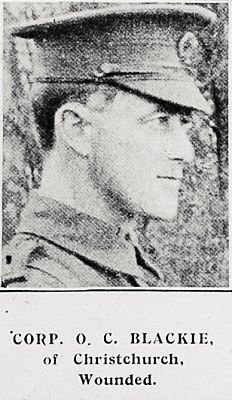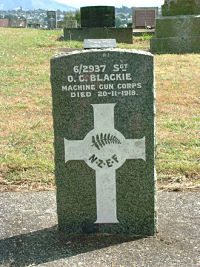WW1 Blackie Brothers — Owen Campbell Blackie
Sergeant Owen Campbell Blackie (service no. 6/2937) was born 2 June 1884 in Calcutta, India, the son of Henry George and Sarah Ann Blackie. He was the eldest of the four Blackie brothers who served in World War I.
Before enlisting he was working as a cabinet maker for H. Pannett, at Motunau, near Christchurch. He was nearly 33 years of age when he enlisted on 12 June 1915, at 5ft 4 ½ in tall with medium complexion, blueish grey eyes and brown hair. He was assigned to the Canterbury Infantry as a private. His keenness to enlist shows in his enlistment record where it states that his preference was to be in the ‘Special Infantry Division if that goes before the next reinforcements, Otherwise, he would be ready to go within a fortnight.’
After training, he was promoted to corporal and embarked from Wellington on 9 October 1915 for Suez, Egypt, disembarking 18 November 1915. [1] As part of the reorganisation of New Zealand Expeditionary Force, he was transferred to the Machine Gun Section on 19 January 1916 and embarked for France on 6 April 1916. Owen and two of his brothers, Bernard (6/3252) and Walter (6/3253), took up machine gun work and for a time were fighting side by side in the same section.
Owen received a gunshot wound to his left hand on 1 October 1916 and was evacuated to England for treatment. After recovering, he underwent more training at the Machine Gun Depot at Grantham, England and was promoted to corporal. Owen left for France again on 28 May 1917 and was promoted to sergeant on 23 September 1917. He was at Passchendaele when the New Zealanders made their attack on 12th October 1917. This first Passchendaele assault foundered in the face of determined enemy resistance, difficult terrain and appalling weather conditions. Eventually all that was gained, at horrendous cost in New Zealand lives and causalities, (3,700), were a few kilometres of ground that included the ruins of Passchendaele. It was the blackest day in New Zealand’s post-1840 existence. [2], [3], [4], [5].
Owen suffered a gunshot wound to his neck on 13 October 1917 during the attack on Passchendaele, now (Passendale) in Flanders, Belgium. He was evacuated to hospital in England where the bullet that had passed through his neck was removed from his arm and he was classed as seriously ill. On 19 November 1917, he was classed as ‘no longer fit for military service’. On 20 November 1917, he returned to New Zealand on board the hospital ship ‘Marama’. After time convalescing, he faced a medical review board and was discharged on 16 February 1918 as: ‘no longer fit for military service on account of wounds received in action causing an arteriovenous aneurysm’.
Sadly, he contracted Influenza and died 20 November 1918 at Te Awamutu. The 1918 influenza virus was many times deadlier than any previous influenza outbreaks in New Zealand. No other event has killed so many New Zealanders in so short a space of time. While the First World War claimed the lives of more than 18,000 New Zealand soldiers over a four-year period, the wave of the 1918 influenza epidemic killed almost 8,600 people in less than two months. He is buried in the Te Awamutu cemetery. [6].
His name appears on the Honour Board of the Oxford Terrace Baptist Church and in the Sydenham Baptist Church Roll of Honour in Christchurch. His name is also listed in the Auckland Baptist Tabernacle, where there are two illuminated brass tablets listing his name alongside the names of 33 men who had fought in World War I [7], [8], [9].

